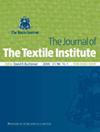A simulation approach to auxetic and non-auxetic behavior of 3D composites produced with multi-cell flat-knitted spacer fabrics
IF 1.5
4区 工程技术
Q2 MATERIALS SCIENCE, TEXTILES
引用次数: 0
Abstract
AbstractThe paper aims to simulate the auxetic and non-auxetic behavior of 3D composites reinforced with multi-cell flat-knitted spacer fabrics. Spacer weft knitted preforms were fabricated on an electronic flat knitting machine. 3D knitted composite samples with re-entrant, regular hexagonal and spear-head geometries, were prepared via vacuumed assisted resin transfer molding method. Using a cross-over geometrical model surrounded by a rigid resin cube, the composite unit-cell was designed in Abaqus software’s environment. Chamis micromechanical model was then used to determine the elastic constants of composite unit-cell. Meso-macro finite element analysis was used to simulate the response of the 3D composites to compressive loading. The results revealed that the Poisson’s ratio of re-entrant and hexagonal 3D knitted composite varied between −6 and −1 and 1.6 to 3.8, respectively. Also, the Poisson’s ratio of spear-head knitted composite was measured as zero. The proposed model was used to verify the predicted compressive behavior and Poisson’s ratio of the prepared composite samples. For hexagonal knitted composite, the proposed model demonstrated a good agreement with the experimental results. The Poisson’s ratio-strain curve obtained for 3D re-entrant knitted composite is highly compatible to those due to modelling results in strain range of about 5.8 to 22.5%. Also, for 3D spear-head knitted composite, the modelling results are not compatible to experimental method at strain values over 6%.Keywords: Auxetic materialsPoisson’s ratiomulti-cell flat-knitted spacer fabricsfinite element method Disclosure statementNo potential conflict of interest was reported by the authors.多单元平编间隔织物三维复合材料消长与非消长性能的仿真研究
摘要本文旨在模拟多单元平编间隔织物增强三维复合材料的形变和非形变行为。在电子横机上制备了间隔纬针织预制品。采用真空辅助树脂转移模塑方法制备了具有复入、正六边形和矛形几何形状的三维针织复合材料样品。采用刚性树脂立方体包围的交叉几何模型,在Abaqus软件环境中设计复合单元格。采用Chamis细观力学模型确定复合材料单元胞的弹性常数。采用细观-宏观有限元方法模拟三维复合材料在压缩载荷作用下的响应。结果表明:重入型和六边形三维针织复合材料的泊松比分别在−6 ~−1和1.6 ~ 3.8之间。同时,测得针尖复合材料的泊松比为零。利用该模型对所制备的复合材料试样的压缩性能和泊松比进行了验证。对于六方针织复合材料,该模型与实验结果吻合较好。三维复入型针织复合材料的泊松比应变曲线与模拟结果在5.8 ~ 22.5%的应变范围内具有较高的相容性。对于三维针尖复合材料,当应变值大于6%时,模拟结果与实验结果不一致。关键词:增材材料spoisson氏多细胞平编间隔织物有限元法披露声明作者未报告潜在利益冲突。
本文章由计算机程序翻译,如有差异,请以英文原文为准。
求助全文
约1分钟内获得全文
求助全文
来源期刊

Journal of the Textile Institute
工程技术-材料科学:纺织
CiteScore
4.20
自引率
5.90%
发文量
149
审稿时长
1.0 months
期刊介绍:
The Journal of The Textile Institute welcomes papers concerning research and innovation, reflecting the professional interests of the Textile Institute in science, engineering, economics, management and design related to the textile industry and the use of fibres in consumer and engineering applications. Papers may encompass anything in the range of textile activities, from fibre production through textile processes and machines, to the design, marketing and use of products. Papers may also report fundamental theoretical or experimental investigations, including materials science topics in nanotechnology and smart materials, practical or commercial industrial studies and may relate to technical, economic, aesthetic, social or historical aspects of textiles and the textile industry.
All published research articles in The Journal of The Textile Institute have undergone rigorous peer review, based on initial editor screening and anonymized refereeing by two expert referees.
 求助内容:
求助内容: 应助结果提醒方式:
应助结果提醒方式:


